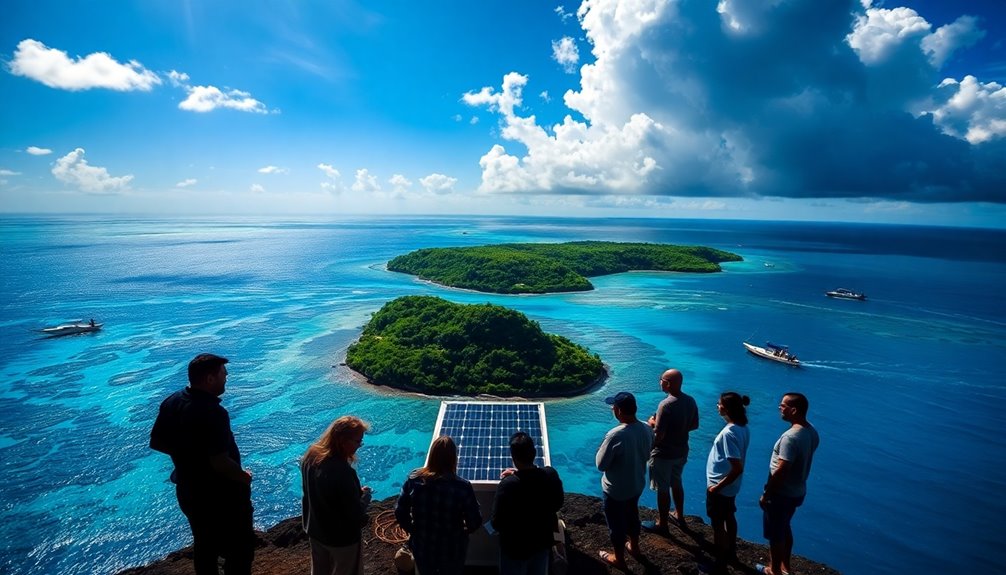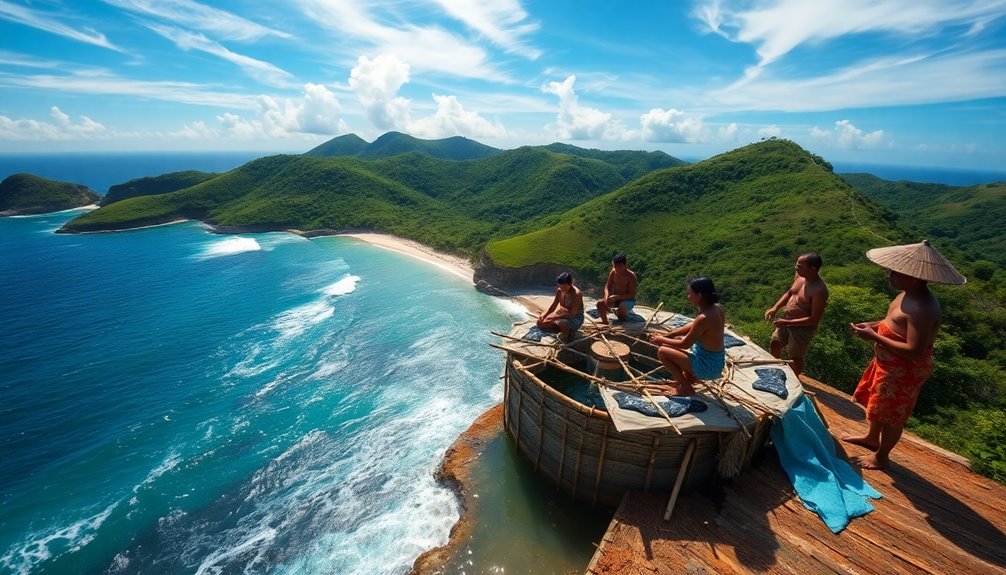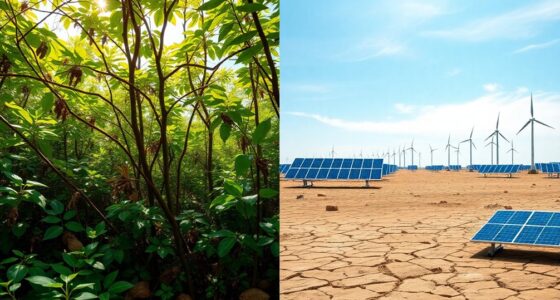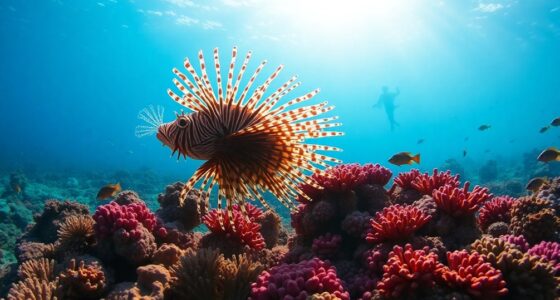Securing water for the Pacific Islands demands innovative solutions. Climate change has worsened water scarcity, especially in rural areas, where access can dip to just 44%. To tackle this, you'll want to consider community water tanks and gender-inclusive policies that empower women in water management. Additionally, advocating for new funding sources is crucial. By exploring these strategies, you can help ensure a sustainable water supply for future generations in these vulnerable regions. More insights await you.
Key Takeaways
- Implement innovative rainwater harvesting systems to enhance water access, especially in rural communities facing severe scarcity.
- Develop climate-resilient water management plans to mitigate the impacts of extreme weather on existing infrastructure.
- Foster community coalitions that include women in decision-making for effective water resource management and sustainability.
- Seek creative financial solutions and collective action to overcome funding limitations for water infrastructure development.
- Prioritize the collection and analysis of sex-disaggregated data to inform gender-inclusive water management strategies.

As climate change intensifies, securing water for Pacific Islands has become a pressing challenge that demands immediate attention. You mightn't realize just how much climate change exacerbates water stress in these regions, affecting both rainwater and groundwater resources. For many islanders, rainwater harvesting is a key strategy since limited surface and groundwater resources make it essential for survival.
However, atoll nations like Tuvalu and Kiribati constantly grapple with water scarcity, as they lack rivers and face increasing threats from sea-level rise, which contaminates groundwater with saltwater. Additionally, many Pacific countries fall short of Millennium Development Goal targets for water supply and sanitation, further complicating access to clean water.
Atoll nations like Tuvalu and Kiribati face severe water scarcity due to rising sea levels contaminating their limited groundwater resources.
To tackle these challenges, long-term strategies for sustainable water management are crucial. Unfortunately, only about 55% of people in Pacific Islands have access to basic drinking water, with rural areas suffering the most. While urban access to clean water is around 92%, it plummets to 44% in rural communities.
Innovative solutions, such as community water tanks, are essential to bridge these gaps, especially as pollution from waste and agricultural runoff compromises water quality.
You also need to consider the impact of climate variability. Rainfall can vary dramatically, up to 54% in some islands, significantly affecting water reliability. Increased extreme weather events can damage existing water infrastructure and contaminate sources, making it even more critical to develop climate-resilient water management plans.
Community involvement is vital in this process. Communities can form coalitions to manage water resources and monitor quality effectively. Women often play a significant role in water collection and management, highlighting the need for gender-inclusive policies.
By collecting sex-disaggregated data, you can improve water management strategies and address gender disparities.
In the face of limited financial resources, you must advocate for innovative funding solutions to develop and maintain water infrastructure. Securing water for Pacific Islands requires bold new ideas and collective action to ensure a sustainable future.
Frequently Asked Questions
What Innovative Technologies Are Being Explored for Water Security in the Pacific Islands?
You'll find that innovative technologies for water security in the Pacific Islands focus on expanding desalination and improving wastewater management.
Systems like reverse osmosis purify seawater efficiently, while decentralized solutions handle wastewater, allowing for reuse in irrigation.
Groundwater management techniques, such as infiltration galleries, help combat saltwater intrusion.
Additionally, integrating renewable energy into these processes aims to enhance sustainability.
Local communities are actively involved in these initiatives, ensuring they meet specific needs and challenges.
How Do Climate Change Impacts Affect Water Availability in These Regions?
Did you know that by 2100, sea levels could rise 1–4 feet, threatening freshwater sources in Pacific Islands?
Climate change drastically affects water availability through rising sea levels, which leads to saltwater intrusion. You might notice altered rainfall patterns increasing evaporation and reducing streamflow.
As droughts and floods become more frequent, your community's water security suffers. Pollution from human activities worsens the situation, making it critical to address these challenges for sustainable water management.
What Role Do Local Communities Play in Water Management Strategies?
Local communities play a crucial role in water management strategies by actively participating in governance and decision-making processes.
You contribute through collective action and by leveraging social relationships built on trust and reciprocity.
By integrating traditional practices with modern techniques, you enhance resilience against climate change impacts.
Your involvement in education and capacity-building efforts helps ensure that water management is effective and tailored to the unique needs of your community.
Are There Successful Case Studies From Other Regions That Can Be Applied Here?
Absolutely! You can look at successful case studies like drip irrigation from the Western United States, which reduces water waste by targeting crop roots.
Collaborative governance, as seen in various regions, shows that sharing data between government and private sectors enhances water management.
Additionally, community engagement in water safety planning has proven effective globally, demonstrating that localized solutions can lead to significant improvements in water efficiency and sustainability.
How Can International Cooperation Improve Water Security for Pacific Island Nations?
You might think international cooperation isn't that impactful, but it's crucial for enhancing water security in Pacific island nations.
By pooling resources and sharing technology, countries can tackle water scarcity more effectively. Collaborative efforts lead to better funding opportunities and innovative solutions like rainwater harvesting and wastewater treatment.
Plus, engaging international partners fosters knowledge exchange, ensuring local communities benefit from global expertise, ultimately making water management more sustainable and resilient against climate challenges.
Conclusion
As you stand on the sun-kissed shores of the Pacific Islands, imagine crystal-clear waves lapping at your feet, whispering the urgent need for innovation. The vibrant colors of coral reefs remind you that each drop of water is precious. By embracing bold ideas, you can help safeguard this life-giving resource, ensuring that future generations enjoy the same breathtaking beauty. Let's unite in creativity and action, turning the tide for water security in these cherished islands.






